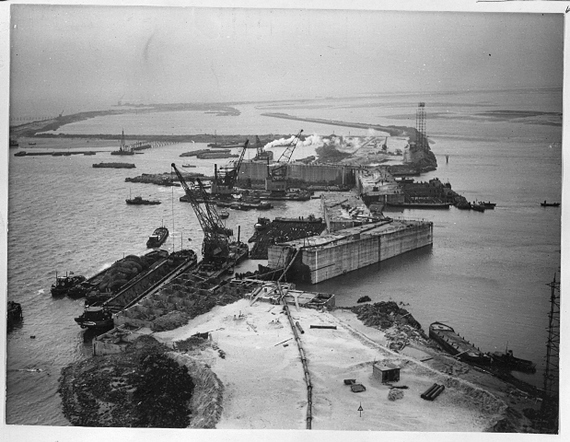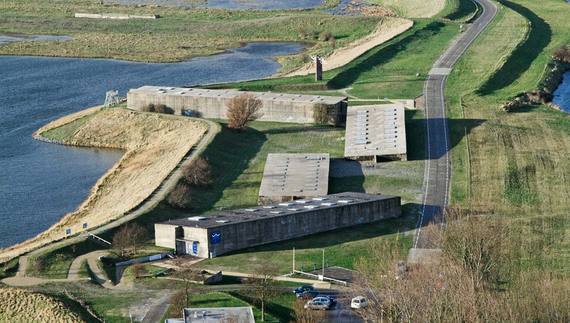Some people have the difficult job of imagining worst case scenarios so they can plan actions to prevent or mitigate catastrophic events. Unfortunately, dreaming up the consequences of, say, a storm surge on a populated area, is not as difficult as convincing the-powers-that-be to invest in civic projects that will assuage the damage should the worst case scenario actually take place. What are the odds of such an event? Once in a hundred years? Two-hundred fifty years? We are lulled into a false sense of security. Of course, the statistics belie the fact that such an event could happen in the near future. The result: Catastrophes occur and they become wake-up calls to action. Katrina and Sandy have done their job. New Orleans has built an enormous defense against the next Katrina, Rebuild by Design is diligently planning for the next Sandy.
I have just returned from a trip to the Netherlands where they've been defending against flooding from the North Sea for the past thousand years. Most of the western part of the country is land reclaimed from the sea and defended against it by an elaborate system of dikes, drainage canals, and pumps. Yet their moment of truth came in the form of an exceptionally long (32-hour) storm on February 1, 1953. The storm surge plus an exceptionally high spring tide added up to wall of water almost 15 feet high. The dikes could not withstand the onslaught. They were overtopped and breached in many places. The water rose rapidly on sleeping, unsuspecting people causing 1,835 (plus one unnamed newborn) deaths and 70,000 evacuees over 560 square miles of inundated farmland.
 Fortunately, plans for preventing such a disaster had been drawn up long before 1953. There was now will, indeed, urgency to build The Delta Works -- an ambitious multifaceted project to raise and fortify dunes and dikes and build new dams, sluices and storm surge barriers that could close off the estuaries whenever the once-in-every-two-hundred-fifty-years storm arrived. The most spectacular achievement of the Delta Works is the enormous hydraulic flood gate, on the scale of two horizontal Eiffel Towers, that can shut off and protect Europe's key shipping center, Rotterdam harbor.
Fortunately, plans for preventing such a disaster had been drawn up long before 1953. There was now will, indeed, urgency to build The Delta Works -- an ambitious multifaceted project to raise and fortify dunes and dikes and build new dams, sluices and storm surge barriers that could close off the estuaries whenever the once-in-every-two-hundred-fifty-years storm arrived. The most spectacular achievement of the Delta Works is the enormous hydraulic flood gate, on the scale of two horizontal Eiffel Towers, that can shut off and protect Europe's key shipping center, Rotterdam harbor.
After the 1953 flood subsided, the Dutch stoically went about rebuilding their lives, never discussing the horrors of that experience or honoring those who died. Ria Geluk lived through the first two nights of that flood on the roof of her family's farmhouse. Her grandparents and aunt lived across the street and perished. She was six years old. More than forty years later she decided to found a museum to tell the story that had been bottled up in the hearts and souls of so many survivors for so many years.
The Watersnood (Flood Disaster) Museum, which opened in 2004, is in four caissons -- huge concrete boxes that were used originally to repair a breach in a dyke. Each caisson has a theme. The second deals with the emotions of the survivors. It features an extraordinary memorial -- a dark room where visitors walk out on a bridge over what looks like a stream of water. The illuminated names of the victims appear to float on the rippling stream as they are carried out to sea.
Have the Delta Works done the job? Yes and no. The Dutch have not suffered another disastrous flood since 1953 but they are not resting on their oars. They take climate change seriously and are planning for the rest of this century by expecting that the sea level will rise by 3 feet. Their philosophy has changed from defending against flooding to finding ways to live with water.
For example, to restore eroded beaches they have invented "the sand motor." It is a huge peninsula created from tons of sand dredged from the bottom of the sea. Nature does the work of redistributing the sand to create new beach over a period of fifteen years. Make no mistake, the Dutch are threatened by the sea from the west, the rivers from the east, rising ground water from below and increasingly heavy downpours from above. They know that their very survival depends on water management and they are exporting their expertise all over the world. The Dutch helped rebuild New Orleans and are involved in many projects along the East Coast.
One thing is certain, if we haven't learned the lesson that our recent storms have taught us, we'll have another opportunity to do so in the future. Perhaps the people of the Netherlands have finally wised up.


